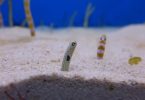Table of Contents
Why is my fish tank cloudy?
This is a frequently asked query in fish keeping. In freshwater, cloudy tank water is a typical issue. The water could be yellow, green, or off-white in color.
Each color represents a different persistent issue with the aquarium, such as water tannins, floating algae, or a bacteria bloom.
In most cases, cloudy aquarium water poses no immediate danger to your fish, but it can diminish the tank’s aesthetic value and be a sign of deeper problems, such as poor water quality.
That is why we will look at the causes, solutions, and ways to avoid exposure to cloud water in this article.
See also the complete care guide for Platy fish
Possible causes of cloudy tank.
Bacteria bloom
Bacterial bloom is the most frequent reason for cloudy water in a freshwater aquarium.
When bacteria in a tank suddenly multiply, this phenomenon is known as a “bacterial bloom,” and it typically manifests as a cloudy or milky appearance in the tank’s water due to the high concentration of bacteria.
Bacteria Bloom in new Aquarium
Bacteria blooms in new aquariums are mainly caused by a lack of the nitrogen cycle, which is when beneficial bacteria work to break down waste and convert toxic substances such as ammonia and nitrite into less harmful nitrates.
This process can be hindered if the tank has not been properly cycled or if there is an accumulation of organic waste and high levels of ammonia and nitrite in the substrate. Such conditions may lead to excessive bacterial growth in the aquarium.
Bacteria Bloom Due to Sudden Nutrition Increase
Even after your aquarium tank has cycled, adding a lot of fish or heavy feeding will raise the ammonia and nitrite levels, which could be dangerous for your fish.
Cloudiness in fish tanks is as a result of beneficial bacteria growing rapidly to handle the extra waste produced.
How to Handle Bacterial Bloom
Often, a bacterial bloom occurs when the aquarium lacks sufficient beneficial bacteria to process fish waste. Whatever the reason, don’t get alarmed. Here’s how to resolve it permanently:
The tank has no fish
There is no need to take action to prevent bacteria bloom if there are no fish present in the tank, as would be the case during a fish-free cycle.
Before adding the fish, give the tank cycle process about three weeks to finish. Once the heterotrophs have eaten up the organics and died off, just let nature take its course, and everything will be clear.
Fish in the Aquarium
- The water will clear after 1-2 days, when the floating bacteria will have settled.
- Reduce feeding to every other or third day to prevent food from going bad in the tank.
- To assist in removing organic compounds from water and substrate, perform daily 50% water changes.
- Maintaining a spotless aquarium by taking out litter like dead plants and uneaten food and cleaning the gravel frequently.
- Clean your filters with Tank water. It is a good idea to clean your filters about once a month.
- Sterilization can kill the helpful germs you need, so avoid doing it, but you can clean up the mud that accumulates over time.
Blooming algae
The algae bloom is another potential reason why tank water appears cloudy. The presence of algae blooms causes the tank water to be green.
Algae bloom can happen in a tank when there are too many nutrients present, high levels of light or carbon dioxide are present, or both.
Algae can grow and bloom in an aquarium if it is left in direct sunlight or the lights are kept on for too long.
Excessive sunlight or lengthy periods of light exposure create ideal conditions for algae growth and blooms to form, which can be detrimental to fish and other aquatic life in the aquarium.
To avoid algae growth and blooms, it is important to prevent your aquarium from being exposed to too much sunlight, and to switch the aquarium lights off after a reasonable amount of time.
Additionally, a buildup of extra nutrients from waste can cause an algae bloom.
How to get rid of an algae bloom
- To treat the water, use phosphate remover or RO water.
- Move the aquarium tank out of direct sunlight and use algae scrapers to remove the algae, or Cut back on how long the lights are on.
- Provide high-quality food in the appropriate quantity to reduce food waste.
- Take out any leftover food from the tank.
- Avoid overfeeding to reduce fish waste.
- Use tank water to clean your filters. It is a good idea to clean your filters about once a month.
- Do not overstock the tank with fish at once as this could lead to waste accumulation over time.
Dirty substrate
A third cause of cloud waterlogging is a contaminated substrate. When you add gravel, sand, or new soil to your tank, a cloud of dust or detritus may form in a column of water.
As they travel from the manufacturer to the store, the substrate bags are turned, tossed around, and routed. With every such motion, the substrate inside the bag rubs against itself, dissolving the tiny particles that make up fine dust.
If the substrate isn’t washed thoroughly enough, it will mix with a lot of dirt and create a big cloud.
How to fix cloudy tank due to dirty substrate
Before incorporating the gravel substrate into your tank, it is important to clean it thoroughly. Fill a large plastic bucket or other container with cool water and add the substrate, shaking gently as you pour the water over it.
Continue running the water and shaking the substrate until the water becomes clear and there are no more traces of dirt or dust. Your substrate is now ready to be used.
Tannins
The water in aquariums can occasionally turn yellow or brown. The tannins in the water are to blame for this. Do not become alarmed.
Your plants or your fish won’t be harmed by tannins. You see, when wood, leaves, and seed pods are soaked in water, they release a brown dye. The name of this dark dye is tannin.
The most frequent source of tannins in aquariums is drift wood. As tannins slowly ingest your aquarium, they cause the water to turn a dark yellow color.
This was created by plants as a defense mechanism. They impart a potent bitter flavor to plants that can deter insects from eating them.
How to remove it!
By soaking the wood before adding it to your aquarium, you can get rid of the majority of the tannins.
When it’s too late and the wood has already been placed in your aquarium, take it out and soak it. When you put the driftwood back in your aquarium, any tannins you removed now won’t cause the water to turn colored.
What happens, however, if the water in your aquarium has already turned brown or yellow?
Your best option is to use activated carbon or another kind of chemical filter, like chemical media, which will remove tannins from the water and leave you with water that is crystal clear.
How to stop cloudy tank water
There are ways to permanently get rid of tannins, bacterial bloom, and microalgae, though they can be a real pain. A certain tank imbalance is typically to blame for issues like gray and green water.
Adequate maintenance practices can be of great assistance in dealing with these issues and preventing them permanently.
You must take a few crucial steps seriously in order to stop the recurrence of cloud water tanks:
- Don’t overfeed your fish because any food that isn’t consumed will just go to waste at the bottom of the tank and provide nutrients for the growth of bacteria and algae.
- It is recommended to perform a weekly water change in your aquarium. This should involve replacing 10-20% of the water and siphoning some of the substrate. Doing so will help keep your tank clean and healthy.
- Changing the filter media once a month will help to maintain the effectiveness of your filter.
- Removing dissolved wastes and solid debris from tank water.
- Regular tank cleaning
When you follow these instructions, maintaining the high water quality in your tank shouldn’t be a problem. You are less likely to experience tank water issues if you keep your tank clean.







